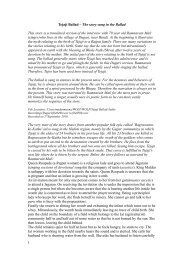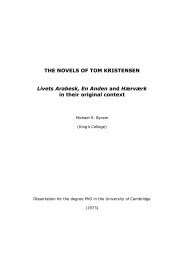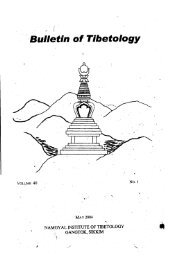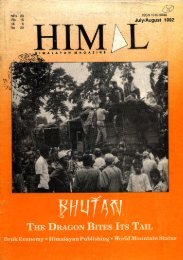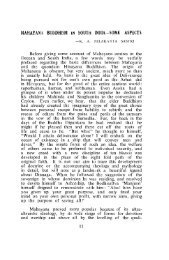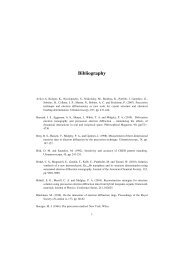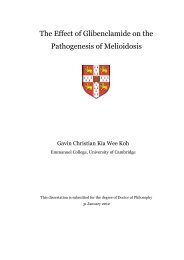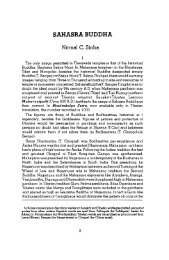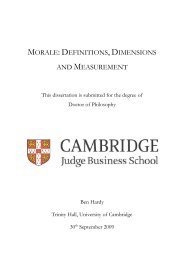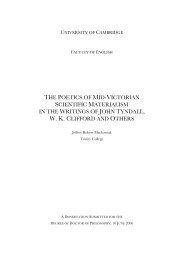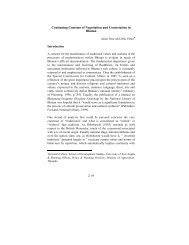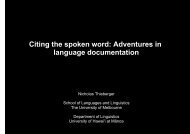The Crusades, the Genoese and the Latin East - DSpace at ...
The Crusades, the Genoese and the Latin East - DSpace at ...
The Crusades, the Genoese and the Latin East - DSpace at ...
You also want an ePaper? Increase the reach of your titles
YUMPU automatically turns print PDFs into web optimized ePapers that Google loves.
following year supply some leads to uncover <strong>the</strong> n<strong>at</strong>ure of rel<strong>at</strong>ions between <strong>the</strong> two important<br />
engagements <strong>the</strong> <strong>Genoese</strong> had <strong>at</strong> <strong>the</strong> time - war <strong>and</strong> commerce.<br />
It is surely not a coincidence th<strong>at</strong> three Spinolas chose Ultramare as <strong>the</strong> first destin<strong>at</strong>ion<br />
for <strong>the</strong>ir commercial venture in 1190. When Guido Spinola was <strong>at</strong> <strong>the</strong> head of <strong>the</strong> commune in<br />
Tyre, <strong>the</strong>y could have expected some benefits. Guglielmo <strong>and</strong> Ingo, two of <strong>the</strong> three sons of<br />
Oberto Spinola, signed contracts in which <strong>the</strong>y were to travel toge<strong>the</strong>r to Ultramare, namely to<br />
Tyre, which was <strong>the</strong> main port city <strong>the</strong>n in <strong>L<strong>at</strong>in</strong> h<strong>and</strong>s <strong>and</strong> <strong>the</strong> beach-head for <strong>the</strong> Third Crusade.<br />
<strong>The</strong>ir bro<strong>the</strong>r Oberto travelled <strong>at</strong> <strong>the</strong> same time <strong>and</strong> was in commercial rel<strong>at</strong>ions with his rel<strong>at</strong>ive,<br />
Consul Guido Spinola, from whom he was supposed to receive some money 66 Consuls of <strong>the</strong><br />
commune were often sent abroad to h<strong>and</strong>le a variety of diplom<strong>at</strong>ic issues, such as <strong>the</strong> negoti<strong>at</strong>ion<br />
of peace tre<strong>at</strong>ies. It is not unusual to find consuls or o<strong>the</strong>r diplom<strong>at</strong>ic represent<strong>at</strong>ives involved in<br />
commercial activities while on official missions abroad. In 1186, for example, Nicola Mallone<br />
<strong>and</strong> Lanfranco Piper, two eminent figures in Genoa, were sent to Constantinople6' <strong>The</strong> tension<br />
between Genoa <strong>and</strong> <strong>the</strong> Byzantine Empire had escal<strong>at</strong>ed after <strong>the</strong> `gre<strong>at</strong> massacre of resident<br />
Italians' in Constantinople in 1182 which turned <strong>the</strong> <strong>Genoese</strong> <strong>and</strong> Pisans in Ralph-Johannes<br />
Lilie's words `into implacable enemies of <strong>the</strong> Emperor. '68Nicola <strong>and</strong> Lanfranco were sent to<br />
Isaac II Angelos after <strong>the</strong> coup which overthrew Andronikos I Komnenos in September 1185. But<br />
<strong>the</strong>ir mission did not bear <strong>the</strong> desired diplom<strong>at</strong>ic fruits for <strong>the</strong>ir home town or bridge <strong>the</strong> h<strong>at</strong>red.<br />
However, it may have possessed a more personal agenda: Nicola is known to have combined this<br />
journey with a business trip, in which he was joined by his bro<strong>the</strong>r Ugo. In a societas contract<br />
between <strong>the</strong> bro<strong>the</strong>rs, from 24 September 1186, <strong>the</strong>y declared a partnership of £150 <strong>and</strong> a<br />
commenda contract of £200 which, according to <strong>the</strong> contract, <strong>the</strong>y intended to take to<br />
Constantinople <strong>and</strong> wherever <strong>the</strong>y mutually decided <strong>the</strong>reafter: `quo tibi et mich! videbitur<br />
proficuum' [my emphasis]<br />
. 69 This is only one example of <strong>the</strong> mixture of diplomacy <strong>and</strong> priv<strong>at</strong>e<br />
enterprise. However, <strong>the</strong> Third Crusade was not like any o<strong>the</strong>r diplom<strong>at</strong>ic activity th<strong>at</strong> could<br />
easily combine trade <strong>and</strong> diplomacy. Commerce during <strong>the</strong> crusade involved serious risks to <strong>the</strong><br />
lives of <strong>the</strong> travelling partners <strong>and</strong> to <strong>the</strong> commodities taken. It cannot be determined whe<strong>the</strong>r <strong>the</strong><br />
660S9 1190, nos. 642,647. <strong>The</strong> commercial arrangement between Oberto <strong>and</strong> Guido Spinola is mentioned<br />
in OS, 1190,655. For ano<strong>the</strong>r commenda contract th<strong>at</strong> involved <strong>the</strong> consuls in Tyre <strong>and</strong> Alamanno<br />
Quartano, see GC, no. 525.<br />
67 Ann. Ian., vol. 2, p. 21.<br />
68 Charles M. Br<strong>and</strong>, `<strong>The</strong> Byzantines <strong>and</strong> Saladin, 1185-1192: Opponents of <strong>the</strong> Third Crusade',<br />
Speculum, 37,2 (April, 1962), p. 168; See also Ralph-Johannes Lilie, Byzantium <strong>and</strong> <strong>the</strong> Crusader St<strong>at</strong>es<br />
1096-1204, trans. J. C. Morris <strong>and</strong> Jean E. Ridings (Oxford, 1993), pp. 227ff; Gerald Day fur<strong>the</strong>r analyses<br />
<strong>the</strong> rel<strong>at</strong>ions between Genoa <strong>and</strong> Byzantine <strong>at</strong> <strong>the</strong> time. Day mentioned an interesting correl<strong>at</strong>ion with <strong>the</strong><br />
factional involvement of <strong>the</strong> Guercio <strong>and</strong> l<strong>at</strong>er <strong>the</strong> Spinola families. See Gerald W. Day, Genoa's Response<br />
to Byzantium, 1155-1204: Commercial Expansion <strong>and</strong> Factionalism in a Medieval City (Urbana, 1988), pp.<br />
115-117.<br />
690S, 1186, no. 40.<br />
34



